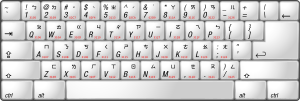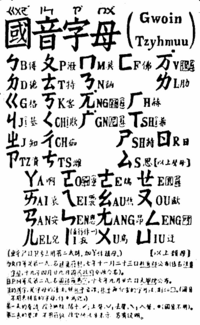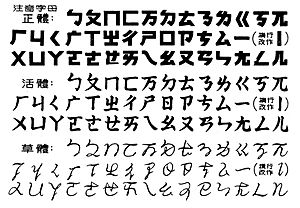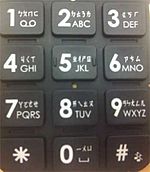Bopomofo facts for kids
Quick facts for kids BopomofoMandarin Phonetic Symbols Zhuyin 注音符號 注音符号 (ㄅㄆㄇㄈ) |
|
|---|---|
| Type | Semisyllabary (letters for onsets and rhymes; diacritics for tones) |
| Created by | Commission on the Unification of Pronunciation Introduced by the Beiyang government of the Republic of China |
| Time period | 1918 to 1958 in mainland China (used supplement Hanyu Pinyin in all editions of Xiandai Hanyu Cidian from 1960 to present 2016 edition); 1945 to the present in Taiwan |
| Parent systems |
Oracle bone script
|
| Child systems | Cantonese Bopomofo, Taiwanese Phonetic Symbols, Suzhou Phonetic Symbols, Hmu Phonetic Symbols, Matsu Fuchounese Bopomofo |
| Sister systems | Simplified Chinese, Kanji, Hanja, Chữ Nôm, Khitan script |
| Unicode range |
|
| ISO 15924 | Bopo |
| Note: This page may contain IPA phonetic symbols in Unicode. | |
| Mandarin Phonetic Symbol | |||||||||||||||||||||||||||||||
|---|---|---|---|---|---|---|---|---|---|---|---|---|---|---|---|---|---|---|---|---|---|---|---|---|---|---|---|---|---|---|---|
| Traditional Chinese | 注音符號 | ||||||||||||||||||||||||||||||
| Simplified Chinese | 注音符号 | ||||||||||||||||||||||||||||||
|
|||||||||||||||||||||||||||||||
Bopomofo (also called Mandarin Phonetic Symbols or Zhuyin) is a special writing system for Chinese. It helps people learn and write the sounds of Mandarin Chinese and other related Chinese languages.
Bopomofo uses 37 characters and five tone marks. These characters can show all the different sounds in Mandarin. It was first created in China in the 1910s. Today, Bopomofo is used more often in Taiwan than in mainland China. It's a popular way to type Chinese characters on computers and phones in Taiwan. It also appears in dictionaries and other documents.
Contents
What is Bopomofo?
Bopomofo is the name given by international groups like ISO and Unicode. The word Zhuyin (Chinese: 注音) means "phonetic notation." This system helps you write down how Chinese words sound.
The name Bopomofo comes from its first four characters: ㄅ, ㄆ, ㄇ, and ㄈ. Just like how the word "alphabet" comes from "alpha" and "beta," Bopomofo gets its name from these first four sounds. These four characters are usually at the beginning of any Bopomofo list.
How Bopomofo Started
Early Days
A group called the Commission on the Unification of Pronunciation created Bopomofo. This happened between 1912 and 1913. They based it on an older shorthand system. The goal was to have an official way to write down the sounds of Chinese characters.
The system was first called Zhuyin Zimu. It became official in 1928. Later, its name was changed to Zhuyin Fuhao. This change happened because some people worried that this new alphabet might replace traditional Chinese characters.
Bopomofo Today
Bopomofo is the main way to teach reading and writing in elementary schools in Taiwan. In younger grades, Chinese characters in textbooks often have small Bopomofo symbols next to them. This helps students learn how to pronounce the words.
One children's newspaper in Taiwan, the Mandarin Daily News, even adds Bopomofo symbols to all its articles. This makes it easier for young readers. Bopomofo is also the most common way for people in Taiwan to type Chinese characters on computers and smartphones. It's also used to look up characters in dictionaries.
Some Chinese communities outside of Taiwan, like those in the Philippines, also use Bopomofo to teach Mandarin.
Bopomofo Symbols
The Bopomofo characters were designed by Zhang Binglin. He took parts of old Chinese characters to create them. Each Bopomofo letter represents a specific sound. For example, the consonant sounds are listed from the front of your mouth to the back. This means sounds like /b/, /p/, /m/, /f/ come first.
| Bopomofo | Origin | Pinyin | WG | Example |
|---|---|---|---|---|
| ㄅ | From 勹, part of 包 bāo (to wrap) | b | p | 包 bāo ㄅㄠ |
| ㄆ | From 攵, a form of 攴 pū (to knock) | p | pʻ | 撲 pū ㄆㄨ |
| ㄇ | From 冂, an old character | m | m | 冞 mí ㄇㄧˊ |
| ㄈ | From 匚 fāng (box) | f | f | 匪 fěi ㄈㄟˇ |
| ㄉ | From 𠚣, an old form of 刀 dāo (knife) | d | t | 地 dì ㄉㄧˋ |
| ㄊ | From 𠫓 tū, an old form of 突 tū (sudden) | t | tʻ | 提 tí ㄊㄧˊ |
| ㄋ | From 𠄎, an old form of 乃 nǎi (be) | n | n | 你 nǐ ㄋㄧˇ |
| ㄌ | From 𠠲, an old form of 力 lì (strength) | l | l | 利 lì ㄌㄧˋ |
| ㄍ | From the old character 巜 guì/kuài (river) | g | k | 告 gào ㄍㄠˋ |
| ㄎ | From the old character 丂 kǎo (breath) | k | kʻ | 考 kǎo ㄎㄠˇ |
| ㄏ | From the old character 厂 hǎn (cliff) | h | h | 好 hǎo ㄏㄠˇ |
| ㄐ | From the old character 丩 jiū | j | ch | 叫 jiào ㄐㄧㄠˋ |
| ㄑ | From the old character 𡿨 quǎn | q | chʻ | 巧 qiǎo ㄑㄧㄠˇ |
| ㄒ | From 丅, an old form of 下 xià (down) | x | hs | 小 xiǎo ㄒㄧㄠˇ |
| ㄓ | From 𡳿, an old form of 之 zhī | zhi, zh- | ch | 知 zhī ㄓ; 主 zhǔ ㄓㄨˇ |
| ㄔ | From 彳 chì | chi, ch- | chʻ | 吃 chī ㄔ; 出 chū ㄔㄨ |
| ㄕ | From 𡰣, an old form of 尸 shī (corpse) | shi, sh- | sh | 是 shì ㄕˋ; 束 shù ㄕㄨˋ |
| ㄖ | From 日 rì (day/sun) | ri, r- | j | 日 rì ㄖˋ; 入 rù ㄖㄨˋ |
| ㄗ | From 卩 jié | zi, z- | ts | 字 zì ㄗˋ; 在 zài ㄗㄞˋ |
| ㄘ | From 𠀁, an old form of 七 qī (seven) | ci, c- | tsʻ | 詞 cí ㄘˊ; 才 cái ㄘㄞˊ |
| ㄙ | From the old character 厶 sī | si, s- | s | 四 sì ㄙˋ; 塞 sāi ㄙㄞ |
| Rhymes and Medials | ||||
| Bopomofo | Origin | Pinyin | WG | Example |
| ㄚ | From 丫 yā | a | a | 大 dà ㄉㄚˋ |
| ㄛ | From the old character 𠀀 hē | o | o | 多 duō ㄉㄨㄛ |
| ㄜ | From ㄛ o | e | o/ê | 得 dé ㄉㄜˊ |
| ㄝ | From 也 yě (also) | |||
| ㄞ | From 𠀅 hài, an old form of 亥 | ai | ai | 晒 shài ㄕㄞˋ |
| ㄟ | From 乁 yí (to move) | ei | ei | 誰 shéi ㄕㄟˊ |
| ㄠ | From 幺 yāo | ao | ao | 少 shǎo ㄕㄠˇ |
| ㄡ | From 又 yòu | ou | ou | 收 shōu ㄕㄡ |
| ㄢ | From the old character 𢎘 hàn (to bloom) | an | an | 山 shān ㄕㄢ |
| ㄣ | From 𠃉, an old variant of 鳦 yǐ | en | ên | 申 shēn ㄕㄣ |
| ㄤ | From 尢 wāng | ang | ang | 上 shàng ㄕㄤˋ |
| ㄥ | From 𠃋, an old form of 肱 gōng | eng | êng | 生 shēng ㄕㄥ |
| ㄦ | From 儿, part of 兒 ér | er | êrh | 而 ér ㄦˊ |
| ㄧ | From 一 yī (one) | yi, -i | i | 以 yǐ ㄧˇ; 逆 nì ㄋㄧˋ |
| ㄨ | From 㐅, an old form of 五 wǔ (five) | w, wu, -u | u/w | 努 nǔ ㄋㄨˇ; 我 wǒ ㄨㄛˇ |
| ㄩ | From the old character 凵 qū | yu, -ü | ü/yü | 雨 yǔ ㄩˇ; 女 nǚ ㄋㄩˇ |
| ㄭ |
From the character 帀. It shows a special vowel sound. | |||
How to Write Bopomofo
Stroke Order
You write Bopomofo characters using the same stroke order rules as Chinese characters. For example, ㄖ has three strokes, even though the Chinese character it comes from (Chinese: 日; pinyin: rì) has four.
The character ㄧ can be written as a vertical line or a horizontal line. Both ways are correct. In Taiwan, it's usually taught as a horizontal line.
Tone Marks
Mandarin Chinese has different tones, which change the meaning of a word. Bopomofo uses special marks to show these tones.
| Tone | Bopomofo | Pinyin | ||
|---|---|---|---|---|
| Tone Marker | Unicode Name | Tone Marker | Unicode Name | |
| 1 | ˉ | Modifier Letter Macron (usually not shown) |
◌̄ | Combining Macron |
| 2 | ˊ | Modifier Letter Acute Accent | ◌́ | Combining Acute Accent |
| 3 | ˇ | Caron | ◌̌ | Combining Caron |
| 4 | ˋ | Modifier Letter Grave Accent | ◌̀ | Combining Grave Accent |
| 5 | ˙ | Dot Above | · | Middle Dot (usually not shown) |
Bopomofo works well with Chinese characters printed vertically in books. It's often placed to the right or above the Chinese character. This helps you pronounce the word correctly.
Example
Here's how the word "bottle" (pinyin: píngzi) looks with Bopomofo:
|
, |
|
or |
|
Bopomofo and Pinyin
Bopomofo and pinyin are both ways to write Mandarin sounds. They are based on the same pronunciations, so each Bopomofo character has a matching Pinyin letter or combination.
| Rhyme | |||||||||||||||
|---|---|---|---|---|---|---|---|---|---|---|---|---|---|---|---|
| ㄚ | ㄛ | ㄜ | ㄝ | ㄞ | ㄟ | ㄠ | ㄡ | ㄢ | ㄣ | ㄤ | ㄥ | ㄦ | |||
| Medial | ㄭ 1 -i |
ㄚ a -a |
ㄛ 3 o -o 3 |
ㄜ e -e |
ㄝ ê |
ㄞ ai -ai |
ㄟ ei -ei |
ㄠ ao -ao |
ㄡ ou -ou |
ㄢ an -an |
ㄣ en -en |
ㄤ ang -ang |
ㄥ eng -eng |
ㄦ er |
|
| ㄧ | ㄧ yi -i |
ㄧㄚ ya -ia |
ㄧㄛ yo |
ㄧㄝ ye -ie |
ㄧㄞ yai |
ㄧㄠ yao -iao |
ㄧㄡ you -iu |
ㄧㄢ yan -ian |
ㄧㄣ yin -in |
ㄧㄤ yang -iang |
ㄧㄥ ying -ing |
||||
| ㄨ | ㄨ wu -u |
ㄨㄚ wa -ua |
ㄨㄛ 3 wo -uo 3 |
ㄨㄞ wai -uai |
ㄨㄟ wei -ui |
ㄨㄢ wan -uan |
ㄨㄣ wen -un |
ㄨㄤ wang -uang |
ㄨㄥ weng -ong 4 |
||||||
| ㄩ | ㄩ yu -ü 2 |
ㄩㄝ yue -üe 2 |
ㄩㄢ yuan -üan 2 |
ㄩㄣ yun -ün 2 |
ㄩㄥ yong -iong |
||||||||||
1 Not usually written.
2 The ü sound is written as u after j, q, x, or y in Pinyin.
3 ⟨ㄨㄛ⟩/⟨-uo⟩ is written as ⟨ㄛ⟩/⟨-o⟩ after ⟨ㄅ⟩/⟨b-⟩, ⟨ㄆ⟩/⟨p-⟩, ⟨ㄇ⟩/⟨m-⟩, ⟨ㄈ⟩/⟨f-⟩.
4 ⟨weng⟩ is pronounced as ⟨-ong⟩ when it follows a starting sound.
| IPA | ɑ | ɔ | ɤ | aɪ | eɪ | ɑʊ | ɤʊ | an | ən | ɑŋ | ɤŋ | ɑɻ | ʊŋ | ji | iɛ | iɤʊ | iɛn | jin | jiŋ |
| Pinyin | a | o | e | ai | ei | ao | ou | an | en | ang | eng | er | ong | yi | ye | you | yan | yin | ying |
|---|---|---|---|---|---|---|---|---|---|---|---|---|---|---|---|---|---|---|---|
| Tongyong Pinyin | a | o | e | ai | ei | ao | ou | an | en | ang | eng | er | ong | yi | ye | you | yan | yin | ying |
| Wade-Giles | a | o | o/ê | ai | ei | ao | ou | an | ên | ang | êng | êrh | ung | i | yeh | yu | yen | yin | ying |
| zhuyin | ㄚ | ㄛ | ㄜ | ㄞ | ㄟ | ㄠ | ㄡ | ㄢ | ㄣ | ㄤ | ㄥ | ㄦ | ㄨㄥ | ㄧ | ㄧㄝ | ㄧㄡ | ㄧㄢ | ㄧㄣ | ㄧㄥ |
| example | 阿 | 哦 | 俄 | 艾 | 黑 | 凹 | 偶 | 安 | 恩 | 昂 | 冷 | 二 | 中 | 一 | 也 | 又 | 言 | 音 | 英 |
| IPA | wu | uɔ | ueɪ | uan | uən | uʊn | uɤŋ | uʊŋ | y | yɛ | yɛn | yn | yʊŋ |
| Pinyin | wu | wo | wei | wan | wen | weng | yu | yue | yuan | yun | yong | ||
|---|---|---|---|---|---|---|---|---|---|---|---|---|---|
| Tongyong Pinyin | wu | wo | wei | wan | wun | wong | yu | yue | yuan | yun | yong | ||
| Wade-Giles | wu | wo | wei | wan | wên | wêng | yü | yüeh | yüan | yün | yung | ||
| zhuyin | ㄨ | ㄨㄛ | ㄨㄟ | ㄨㄢ | ㄨㄣ | ㄨㄥ | ㄩ | ㄩㄝ | ㄩㄢ | ㄩㄣ | ㄩㄥ | ||
| example | 五 | 我 | 位 | 完 | 文 | 文 | 翁 | 翁 | 玉 | 月 | 元 | 云 | 用 |
| IPA | p | pʰ | m | fəŋ | fʊŋ | tiou | tuei | tʰ | ny | ly | kəɻ | kʰ | xə | tɕiɛn | tɕyʊŋ | tɕʰɪn | ɕyɛn |
| Pinyin | b | p | m | feng | diu | dui | t | nü | lü | ger | k | he | jian | jiong | qin | xuan | |
|---|---|---|---|---|---|---|---|---|---|---|---|---|---|---|---|---|---|
| Tongyong Pinyin | b | p | m | fong | diou | duei | t | nyu | lyu | ger | k | he | jian | jyong | cin | syuan | |
| Wade-Giles | p | p' | m | fêng | tiu | tui | t' | nü | lü | kêrh | k' | ho | chien | chiung | ch'in | hsüan | |
| zhuyin | ㄅ | ㄆ | ㄇ | ㄈㄥ | ㄉㄧㄡ | ㄉㄨㄟ | ㄊ | ㄋㄩ | ㄌㄩ | ㄍㄜㄦ | ㄎ | ㄏㄜ | ㄐㄧㄢ | ㄐㄩㄥ | ㄑㄧㄣ | ㄒㄩㄢ | |
| example | 玻 | 婆 | 末 | 封 | 封 | 丟 | 兌 | 特 | 女 | 旅 | 歌儿 | 可 | 何 | 件 | 窘 | 秦 | 宣 |
| IPA | tʂə | tʂɚ | tʂʰə | tʂʰɚ | ʂə | ʂɚ | ʐə | ʐɚ | tsə | tsuɔ | tsɨ | tsʰə | tsʰɨ | sə | sɨ |
| Pinyin | zhe | zhi | che | chi | she | shi | re | ri | ze | zuo | zi | ce | ci | se | si |
|---|---|---|---|---|---|---|---|---|---|---|---|---|---|---|---|
| Tongyong Pinyin | jhe | jhih | che | chih | she | shih | re | rih | ze | zuo | zih | ce | cih | se | sih |
| Wade-Giles | chê | chih | ch'ê | ch'ih | shê | shih | jê | jih | tsê | tso | tzŭ | ts'ê | tz'ŭ | sê | szŭ |
| zhuyin | ㄓㄜ | ㄓ | ㄔㄜ | ㄔ | ㄕㄜ | ㄕ | ㄖㄜ | ㄖ | ㄗㄜ | ㄗㄨㄛ | ㄗ | ㄘㄜ | ㄘ | ㄙㄜ | ㄙ |
| example | 哲 | 之 | 扯 | 赤 | 社 | 是 | 惹 | 日 | 仄 | 左 | 字 | 策 | 次 | 色 | 斯 |
| IPA | ma˥˥ | ma˧˥ | ma˨˩˦ | ma˥˩ |
| Pinyin | mā | má | mă | mà |
|---|---|---|---|---|
| Tongyong Pinyin | ma | maˊ | maˇ | maˋ |
| Wade-Giles | ma1 | ma2 | ma3 | ma4 |
| zhuyin | ㄇㄚ | ㄇㄚˊ | ㄇㄚˇ | ㄇㄚˋ |
| example (traditional/simplfied) | 媽/妈 | 麻/麻 | 馬/马 | 罵/骂 |
Bopomofo for Other Chinese Languages
Bopomofo symbols are also used for other Chinese languages, not just Mandarin. These extra symbols are found in the Unicode Bopomofo Extended block.
Taiwanese Hokkien
In Taiwan, Bopomofo helps teach Taiwanese Hokkien. You can see it used on signs, in karaoke lyrics, and in movie subtitles.
Some older Bopomofo letters that are no longer used for Mandarin are still used for Hokkien:
| Bopomofo | GR | Pinyin |
|---|---|---|
| ㄪ | v | v |
| ㄫ | ng | ng |
| ㄬ | gn | gn |
There are also 23 more letters made just for Taiwanese Hokkien.
Cantonese
Bopomofo letters are also used for Cantonese.
| Bopomofo | Jyutping |
|---|---|
| ㆼ | gw |
| ㆽ | kw |
| ㆾ | eo |
| ㆿ | a |
Bopomofo on Computers
Typing Chinese

Bopomofo is a way to type Chinese characters on computers. It's often built into most modern computers, so you don't need to download extra software. It's also used to type Chinese characters on some cell phones. On a standard QWERTY keyboard, the Bopomofo symbols are arranged in columns.
Unicode
Bopomofo characters are part of the Unicode Standard. This means computers all over the world can understand and display them. The main Bopomofo characters were added in 1991. More characters, especially for other Chinese languages, were added later in 1999.
There are also special tone marks for Bopomofo in Unicode:
| Tonal marks for Bopomofo Spacing Modifier Letters |
|||
| Tone | Tone Marker | Unicode | Note |
| 1 Yin Ping (Level) | ˉ | U+02C9 | Usually not shown |
| 2 Yang Ping (Level) | ˊ | U+02CA | |
| 3 Shang (Rising) | ˇ | U+02C7 | |
| 4 Qu (Departing) | ˋ | U+02CB | |
| 4a Yin Qu (Departing) | ˪ | U+02EA | For Minnan and Hakka languages |
| 4b Yang Qu (Departing) | ˫ | U+02EB | For Minnan and Hakka languages |
| 5 Qing (Neutral) | ˙ | U+02D9 | |
See also
 In Spanish: Zhuyin para niños
In Spanish: Zhuyin para niños




